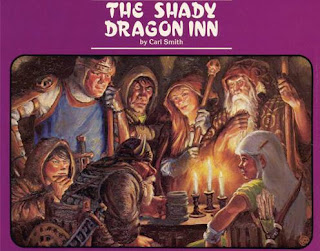More musings on Horror in D&D
Horror in Dungeons & Dragons is a popular post here. I wanted to point out a few situations from last game session and show how easily a bit of horror can work its way into the session (for the entertainment of all). Note: spoilers follow for the module Hammers of the God.
Ankle Biters
Early in the game, the group walked through a room where a thick purple mist covered the floor. They had just passed through the room a short while ago, but on the second time across, a pair of zombies huddling out of sight under the mist grabbed two of the characters by the legs and attacked them.
Quarantine!
The group spiked the door to the purple mist room behind them (which also meant they locked themselves in the dungeon). Later, they discovered the mist room had filled with zombies behind them - they were trapped. They left a bunch of their gear outside the dungeon. Did they have enough supplies? Would they have to fight their way out? The room had roughly 100 corpses - would they have to battle 100 zombies to freedom?
My Biscuits are Burning
Late in the night, they lowered their halfling by rope down a 40' shaft into a dark cave on the next level. Yikes. Scouting ahead alone can be a little stressful. But when a hulking monster rushes out of the dark, breathing fire, it gets really stressful! And when the fire is burning the rope, and there's a chance that everyone is about to see the scout get stuck down there, now we're speaking the horror language. (There were cheers when the rope made its item save vs fire...)
Elements of Horror
The purple mist lent atmosphere and tension just by obscuring the floor, and created the opportunity for monsters to pop up and startle the characters (Atmosphere and Shock/Scare). Getting trapped in a dungeon with a large throng of hungry dead between you and the door creates stress and Resource Pressure. Getting ambushed by a big monster is Danger, and since everyone else is watching the train wreck, it's a bit of Vicarious Horror as well. That James Raggi fellow knows a thing or two about putting good horror tools into the DM's hands (Hammers of the God is a flame princess module).
Any of the situations I described above would be a nice moment in a horror movie. D&D characters are more immured to danger and capable of dealing with adversity, so these horror situations end up being thrilling, stressful (in a good way), challenging and exciting - moments to strive for in your table top game.
Threaten the character, stress the player, enjoy the game.
Could be a new motto for me.
Horror in Dungeons & Dragons is a popular post here. I wanted to point out a few situations from last game session and show how easily a bit of horror can work its way into the session (for the entertainment of all). Note: spoilers follow for the module Hammers of the God.
Ankle Biters
Early in the game, the group walked through a room where a thick purple mist covered the floor. They had just passed through the room a short while ago, but on the second time across, a pair of zombies huddling out of sight under the mist grabbed two of the characters by the legs and attacked them.
Quarantine!
The group spiked the door to the purple mist room behind them (which also meant they locked themselves in the dungeon). Later, they discovered the mist room had filled with zombies behind them - they were trapped. They left a bunch of their gear outside the dungeon. Did they have enough supplies? Would they have to fight their way out? The room had roughly 100 corpses - would they have to battle 100 zombies to freedom?
My Biscuits are Burning
Late in the night, they lowered their halfling by rope down a 40' shaft into a dark cave on the next level. Yikes. Scouting ahead alone can be a little stressful. But when a hulking monster rushes out of the dark, breathing fire, it gets really stressful! And when the fire is burning the rope, and there's a chance that everyone is about to see the scout get stuck down there, now we're speaking the horror language. (There were cheers when the rope made its item save vs fire...)
Elements of Horror
The purple mist lent atmosphere and tension just by obscuring the floor, and created the opportunity for monsters to pop up and startle the characters (Atmosphere and Shock/Scare). Getting trapped in a dungeon with a large throng of hungry dead between you and the door creates stress and Resource Pressure. Getting ambushed by a big monster is Danger, and since everyone else is watching the train wreck, it's a bit of Vicarious Horror as well. That James Raggi fellow knows a thing or two about putting good horror tools into the DM's hands (Hammers of the God is a flame princess module).
Any of the situations I described above would be a nice moment in a horror movie. D&D characters are more immured to danger and capable of dealing with adversity, so these horror situations end up being thrilling, stressful (in a good way), challenging and exciting - moments to strive for in your table top game.
Threaten the character, stress the player, enjoy the game.
Could be a new motto for me.













